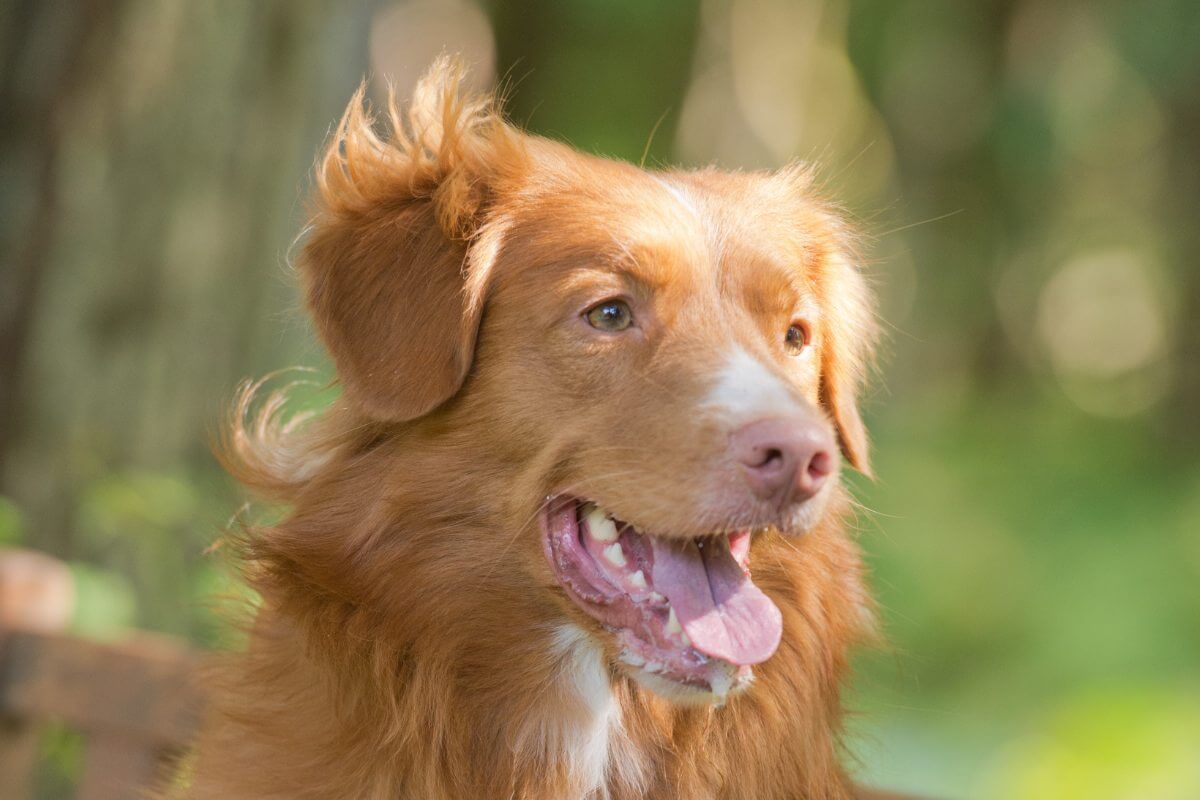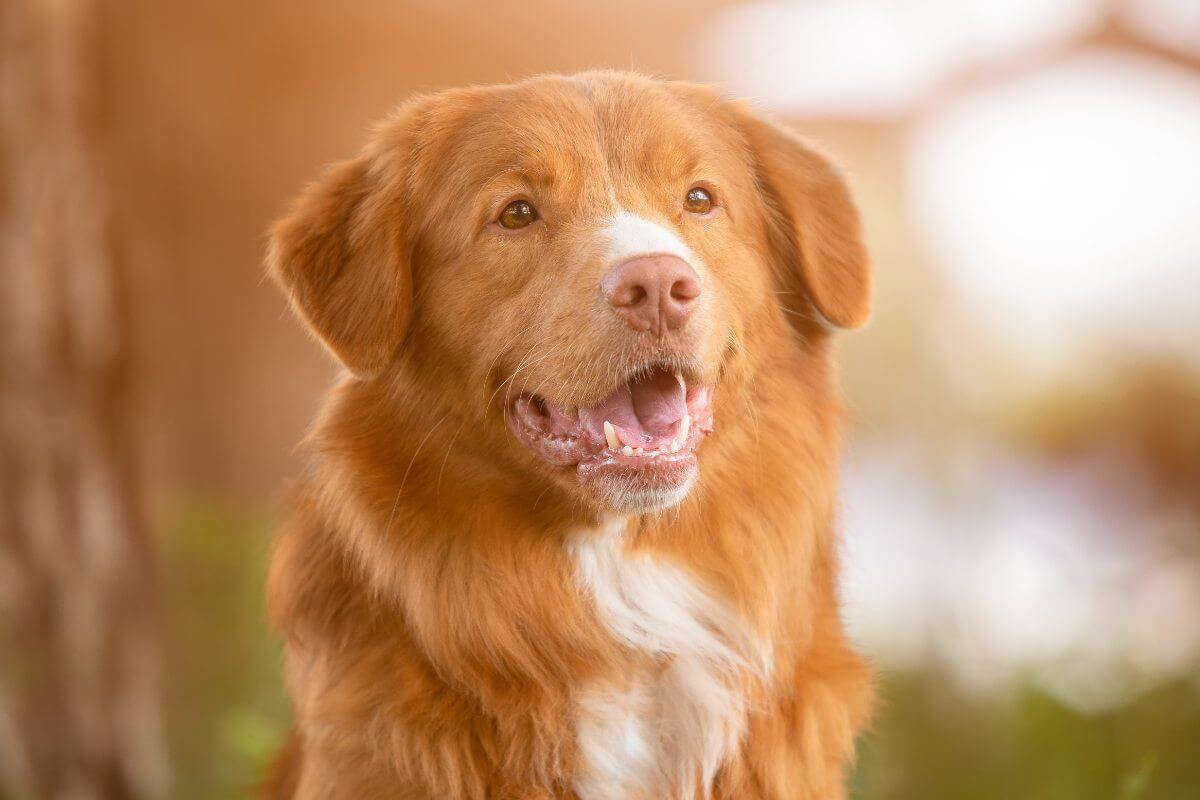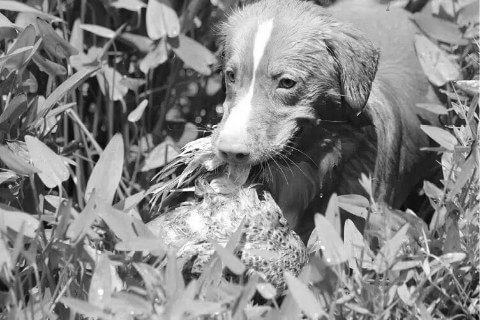Home » Meet The Breeds » Nova Scotia Duck Tolling Retriever



The Nova Scotia Duck Tolling Retriever is a medium-sized, energetic breed known for its remarkable ability to lure and retrieve waterfowl. These dogs are intelligent, versatile, and highly trainable, excelling in various canine activities while maintaining a strong drive to work. Their vibrant personality and affectionate nature make them beloved companions for active families and individuals.
Sporting
17 – 21 inches
35 – 50 pounds
12 – 14 years
| Country of Origin | Canada |
|---|---|
| Bred For | Tolling, Retrieving |
| Known For | Alertness, Birdiness, Intelligence |
| Popularity | Moderate |
| Temperament | Alert, Intelligent, Ready for Action |
| Activities | Hunting, Running, Conformation Shows, Dog Sports |
The Nova Scotia Duck Tolling Retriever has a unique history rooted in the hunting traditions of Nova Scotia, Canada. The breed was developed in the early 19th century to assist hunters in the coastal regions of the province, specifically in luring and retrieving ducks and other waterfowl. The term “tolling” refers to the breed’s characteristic behavior of playfully darting along the water’s edge, mimicking the movements of foxes, which naturally attract the curiosity of ducks. Once the birds are lured within shooting range, the Toller retrieves the downed game.
The breed’s development is believed to involve a combination of several established purebreds, including spaniels, retrievers, setters, and possibly even collies. The goal was to create a dog that was both an adept retriever and a skilled tolling specialist, with a temperament suitable for working closely with hunters.
The “Toller” was first known as the “Little River Duck Dog,” named after the region in Nova Scotia where it was commonly found. Its distinctive red coat and white markings became a hallmark of the breed, both for its aesthetic appeal and its functional visibility in hunting scenarios.
The Canadian Kennel Club (CKC) officially recognized the Nova Scotia Duck Tolling Retriever as a distinct breed in 1945, making it one of the few breeds to originate in Canada. The breed gained international recognition when it was acknowledged by the Fédération Cynologique Internationale (FCI) in 1982, and later, by the American Kennel Club (AKC) in 2003, where it was placed in the Sporting Group.
While the Nova Scotia Duck Tolling Retriever was initially bred as a bird dog, its friendly and adaptable nature has made it increasingly popular as a family companion. Yet despite its rise in popularity, it remains a relatively rare breed, admired for its combination of beauty, intelligence, and functionality. Today, the Toller is celebrated not only for its historical role as a hunting partner but also for its success in dog sports, therapy work, and as a loyal and loving companion.
Male Nova Scotia Duck Tolling Retrievers typically stand between 18 and 21 inches tall at the shoulder, while females measure slightly less, ranging from 17 to 20 inches. Weight is in proportion to height and substance, generally between 35 and 50 pounds.
The Nova Scotia Duck Tolling Retriever is a well-balanced, medium-sized dog that is slightly longer than it is tall. It is compact, balanced, and powerful enough to fulfill the demands of fieldwork. Although it is the smallest of the retrievers, the Toller’s form suggests strength with a high degree of agility.
Texture: The Nova Scotia Duck Tolling Retriever’s double coat is designed for functionality. The outer coat is medium in length, medium-soft to the touch, and water-repellent, while the undercoat is dense and insulating to protect against cold and wet conditions. The hair on the muzzle is short and fine, and moderate feathering is present on the chest, body, and tail, and on the legs where it forms “pantaloons.”
| Standard Color | |
|---|---|
| Red | y |
| Buff | n |
| Red Gold | y |
| Standard Marking | |
|---|---|
| White Markings | y |
A Note About Color: Any shade of red is allowed, ranging from golden red through dark, coppery red. Lighter shades are deeply pigmented and rich in color. Brown, black, or buff in the coat is not permitted. Markings include at least a white blaze on the head, white on the chest, white feet (not extending above the pasterns), and a white tail tip. White around the ears, on the back of the neck, on the shoulders, and across the flanks is unacceptable.

The tail of the Nova Scotia Duck Tolling Retriever is a defining breed feature. It is set following the very slight slope of the croup, and may be carried below the level of the back except when the dog is moving or otherwise excited, when it is held high in a curve. The tail tapers to a point, and is luxuriantly feathered.
The Nova Scotia Duck Tolling Retriever is a highly energetic and intelligent breed that thrives in an environment where it can engage in physical activities and mental challenges. These dogs form strong bonds with their families and require consistent attention, making them best suited for active households that are prepared to meet their needs.
The Nova Scotia Duck Tolling Retriever is generally a healthy breed with a lifespan of 12 to 14 years. Maintaining good health requires regular veterinary check-ups, a well-balanced diet, and adequate physical activity to support an active lifestyle.
While the Toller is robust, it can be prone to certain health conditions, including:
The Nova Scotia Duck Tolling Retriever is an affectionate, intelligent, and playful breed that thrives on human interaction. These dogs are highly people-oriented, forming close bonds with their families and often following their favorite humans from room to room. Tollers are generally friendly with strangers and get along well with children and other pets, making them a great choice as a companion.
While eager to please, Tollers are also known for their independence and occasional stubbornness, which can make training a challenge without consistency and positive reinforcement. They are sensitive to their environment and respond best to gentle and encouraging handling.
Nova Scotia Duck Tolling Retrievers require a high-quality diet that meets their nutritional needs at every stage of life. Puppies benefit from a diet designed for large-breed puppies, which supports controlled growth and helps to prevent joint issues.
Adult Tollers typically consume about 2 to 3 cups of high-quality dog food per day, divided into two meals, to maintain their energy levels and prevent overeating. The exact amount depends on the dog’s age, activity level, and metabolism. Monitoring the dog’s weight and adjusting portion sizes accordingly ensures optimal condition for a lifetime.
Tollers are highly intelligent and eager to learn, making them relatively easy to train with the right approach. Positive reinforcement methods, such as treats, toys, and praise, work best, as these dogs are sensitive and may shut down when harsh training techniques are implemented.
The Toller’s strong prey drive and natural hunting instincts mean early recall training and leash manners are crucial, particularly in areas where distractions like wildlife are present. These dogs can excel in Obedience, Agility, and other canine sports, which not only challenge their minds but also strengthen the bond they share with their human partners. Consistent, engaging training is key to keeping these intelligent dogs mentally stimulated and well-mannered.
Nova Scotia Duck Tolling Retrievers are high-energy dogs with a strong need for daily exercise to keep them healthy and happy. They thrive on activities that challenge both their physical endurance and their mental sharpness, such as long walks, energetic runs, or games of fetch.
| Energy Level | High |
|---|---|
| Exercise Requirements | 1 Hour/Day (Minimum), Daily Walks, Daily Exercise, Swimming |
As natural retrievers, Tollers love water and excel in activities like swimming and Dock Diving, making them ideal companions for families who enjoy outdoor adventures. Without sufficient exercise and stimulation, they may become bored and develop undesirable behaviors, so they are best suited for active households.
Tollers have a double coat that requires regular grooming to keep it clean and healthy. Weekly brushing is sufficient for most of the year, but during seasonal shedding periods more frequent brushing helps with managing the increased hair loss.
| Coat Type | Dense, Medium Length, Medium Softness, Water-Repellent |
|---|---|
| Grooming Requirements | Weekly Brushing, Occasional Bathing, Routine Ear Cleaning, Periodic Nail Trimming, Regular Tooth Brushing |
The breed’s coat is water-repellent and relatively easy to maintain, but feathering on the legs, chest, and tail should be checked for tangles and debris. Routine care, including nail trimming, ear cleaning, and dental hygiene, is essential to keep them comfortable and for preventing health issues.
Tollers adapt well to various living situations, but they are best suited to homes where they have access to outdoor space and plenty of exercise. While they can live in apartments if given sufficient activity, they thrive in larger homes with a securely fenced yard where they can run and play safely.
Tollers are well-equipped for colder climates, thanks to their dense, water-resistant coats, but they may need extra care in hot weather to avoid overheating. As sociable dogs, they do best in households where they can be part of daily activities, since they typically do not handle long periods of isolation very well.
Nova Scotia Duck Tolling Retriever puppies are curious and energetic, requiring early socialization and structured routines to grow into well-rounded adults. Introducing them to new environments, people, and animals during puppyhood helps to develop their confidence and adaptability.
Caring for a Nova Scotia Duck Tolling Retriever puppy involves meeting the little one’s physical, mental, and social needs. A high-quality puppy food designed for large-breed puppies supports controlled growth and helps to prevent joint problems. Meals should be divided into three to four portions daily to avoid overfeeding and promote steady development.
Training should start immediately, focusing on basic obedience, crate training, and house training. Positive reinforcement methods work best, as the Toller pup is eager to learn but can be sensitive to harsh handling. Socialization is equally important to ensure the puppy grows up to be comfortable with new experiences and environments.
Veterinary check-ups are essential for the Toller puppy during the first year to monitor growth and provide vaccinations and preventive care. Establishing grooming routines early, including brushing and nail trimming, accustoms the puppy to being handled and sets the stage for long-term health and hygiene. Balancing exercise and rest is crucial, as overexertion can cause stresses and strains. Short play sessions and interactive games are good for challenging both body and mind.
The Nova Scotia Duck Tolling Retriever is recognized by the world’s leading registries and kennel organizations, which categorize the breed into a specific Group based on its unique characteristics. This breed is recognized worldwide under the following Group designations:
| Organization | Group Designation |
|---|---|
| AKC (American Kennel Club) | Sporting |
| UKC (United Kennel Club) | Gun Dog |
| CKC (Canadian Kennel Club) | Sporting Dogs |
| ANKC (Australian National Kennel Council) | Gundogs |
| RKC (The Royal Kennel Club) | Gundog |
| FCI (Fédération Cynologique Internationale) | Group 7: Pointing Dogs Section 2.1: British and Irish Setters, Pointer |
The ideal Nova Scotia Duck Tolling Retriever is described by a Breed Standard that is approved by each of the world’s leading registries and kennel organizations. The Breed Standards for this breed may be found in the following links:
| Organization | Breed Standard |
|---|---|
| American Kennel Club | AKC NSDTR Breed Standard |
| United Kennel Club | UKC NSDTR Breed Standard |
| Canadian Kennel Club | CKC NSDTR Breed Standard |
| Australian National Kennel Council | ANKC NSDTR Breed Standard |
| The Royal Kennel Club | RKC NSDTR Breed Standard |
| Fédération Cynologique Internationale | FCI NSDTR Breed Standard |
Yes, Nova Scotia Duck Tolling Retrievers shed moderately throughout the year, with heavier shedding during seasonal changes. Regular brushing helps to manage shedding and keeps the double coat in good condition.
No, Tollers are not hypoallergenic. They produce dander and they shed, which can trigger allergies in sensitive individuals.
Nova Scotia Duck Tolling Retrievers typically live between 12 and 14 years. Proper care, including exercise, a healthy diet, and regular veterinary visits, can support longevity.
Yes, Tollers can make excellent family dogs due to their affectionate, friendly, and playful nature. They thrive in active households and get along well with children and other pets when properly socialized.
Nova Scotia Duck Tolling Retrievers are not excessive barkers, but they may bark to alert their human companions or when excited. Early training and socialization can help to manage any undesirable vocalizations.
The best way to ensure a long and happy relationship with a purebred dog is to purchase one from a responsible breeder. Not sure where to begin?
Contact the National Parent Club’s Breeder Referral Program, which is listed on the AKC Breeder Referral Contacts page.
